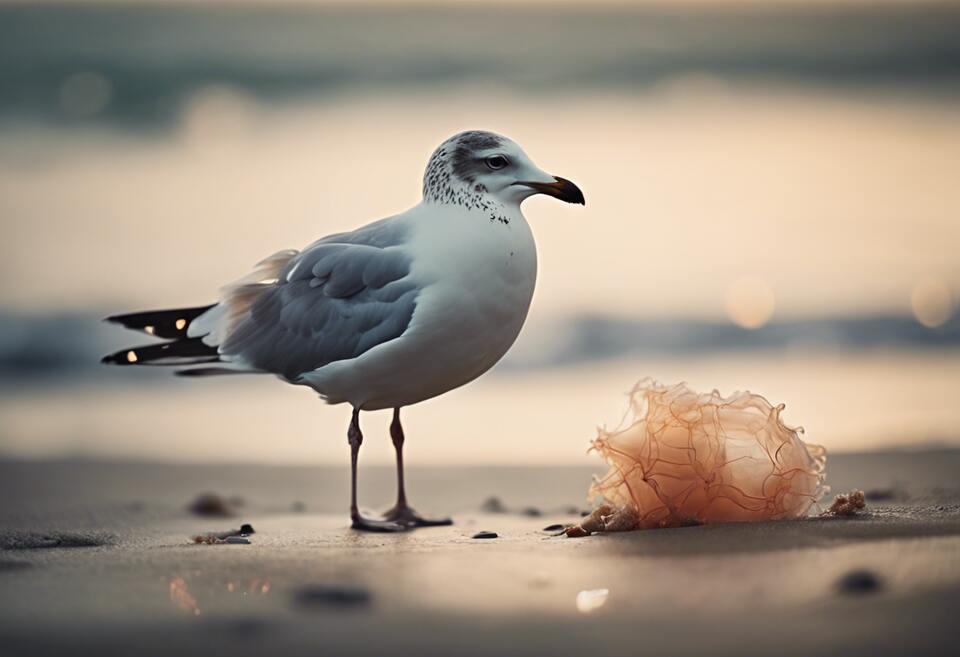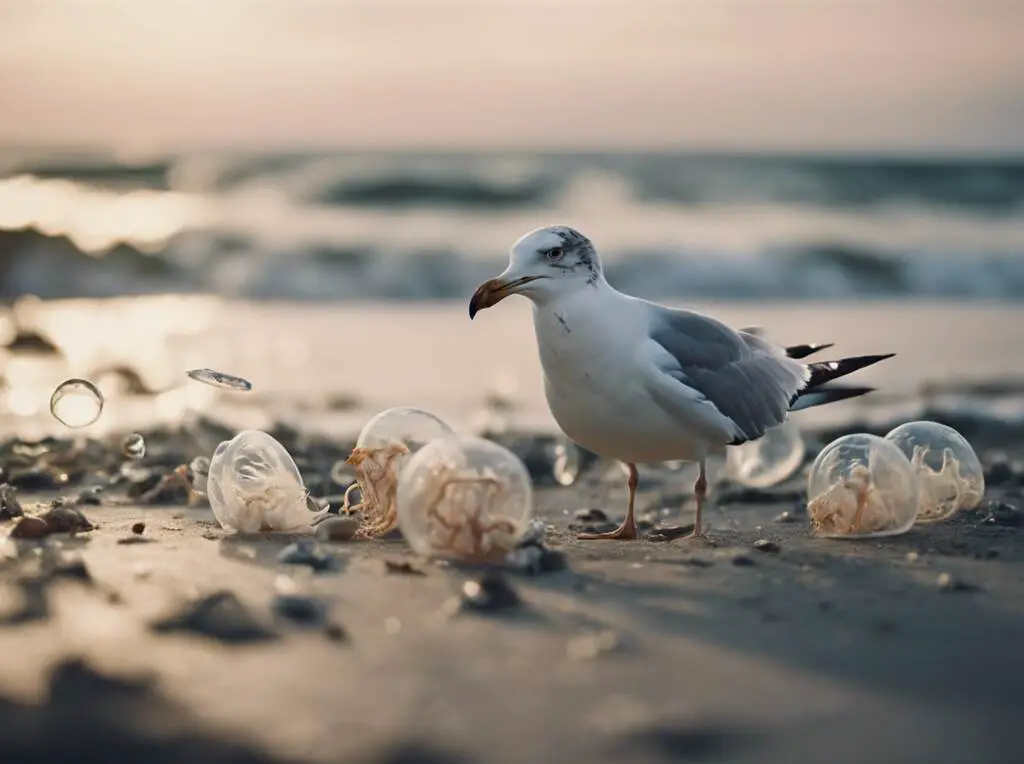Seagulls are fascinating creatures known for their scavenger behavior and adaptability to various food sources. One common question that arises is whether seagulls have a natural appetite for jellyfish. Let’s dive into this intriguing aspect of seagull behavior to uncover the relationship between these birds and the gelatinous creatures of the sea.
Table of Contents
Do Seagulls Have a Natural Appetite for Jellyfish?
Understanding Seagull Diet Patterns
Seagulls are opportunistic feeders with a diverse diet that can vary based on their habitat and surroundings. These birds are known to consume a wide range of food, including fish, small crustaceans, insects, garbage, and even carrion. Their foraging behavior is highly influenced by availability, accessibility, and nutritional content of food sources in their environment.
Do Seagulls Actually Eat Jellyfish?
While seagulls are not specifically known for seeking out jellyfish as a primary food source, they have been observed consuming jellyfish in certain situations. Jellyfish are abundant in many coastal waters worldwide, making them a potential food option for seabirds like seagulls. When other food sources are scarce, seagulls may resort to feeding on jellyfish to fulfill their nutritional requirements.
Factors Influencing Seagull Feeding Behavior
Several factors can influence whether seagulls choose to eat jellyfish. One key factor is the abundance of jellyfish in a particular area. If jellyfish populations are high and other food sources are limited, seagulls may incorporate jellyfish into their diet. Additionally, the size and species of jellyfish can also impact whether seagulls consider them as prey.
Nutritional Value of Jellyfish for Seagulls
Jellyfish are composed of 95% water and have limited nutritional value compared to other prey items in a seagull’s diet. While jellyfish may not be the most energy-rich food source for seagulls, they can still provide some essential nutrients. Seagulls have been known to consume jellyfish as a supplementary food source when needed, especially in times of food scarcity.
Adaptability of Seagulls in Food Choices
Seagulls are highly adaptable birds that can adjust their feeding behavior based on changing environmental conditions. Their ability to switch between different food sources depending on availability and necessity allows them to survive in a variety of habitats. While jellyfish may not be a staple in a seagull’s diet, these birds demonstrate flexibility in their food choices.
While seagulls may not have a natural appetite for jellyfish, they are capable of consuming them when circumstances dictate. The scavenger nature of seagulls enables them to explore various food sources, including jellyfish, to sustain themselves. Understanding the factors that influence seagull feeding behavior sheds light on the complex relationship between these birds and their prey.

The Ecological Significance of Jellyfish Consumption by Seagulls
Jellyfish are fascinating creatures that play a vital role in the marine ecosystem. They are known for their gelatinous bodies and their sometimes painful stings. Seagulls, on the other hand, are opportunistic birds that are commonly found near coastlines and bodies of water. One interesting aspect of seagull behavior is their consumption of jellyfish. This interaction between seagulls and jellyfish holds significant ecological importance and provides insights into the dynamics of marine ecosystems.
Seagulls: The Opportunistic Feeders
Seagulls are opportunistic feeders, meaning they consume a wide variety of prey depending on availability. Their diet can include fish, crustaceans, insects, and even carrion. Seagulls are equipped with sharp beaks that allow them to catch and consume their prey efficiently. They are also skilled at scavenging for food, often seen near fishing boats or scavenging in urban areas for scraps. Their ability to adapt to different food sources makes them highly successful and widespread birds.
Jellyfish: A Unique Prey
Jellyfish are gelatinous sea creatures that come in a variety of shapes and sizes. They have tentacles armed with stinging cells used for capturing prey and defending against predators. Despite their seemingly delicate nature, jellyfish are effective predators in their own right. Their population dynamics are influenced by various factors, including water temperature, food availability, and predation. While jellyfish are not a typical food source for many predators due to their stinging capabilities, some animals have developed strategies to consume them.
The Role of Seagulls in Controlling Jellyfish Populations
Seagulls do not play a crucial role in controlling jellyfish populations through predation. While they do occasionally feed on jellyfish, their impact on regulating jellyfish numbers in marine environments is minimal. Other factors, such as ocean currents, temperature, and more specialized predators such as the thick-billed murre, have a greater influence on jellyfish populations. Therefore, seagulls do not act as a significant natural check on jellyfish numbers, even in areas where jellyfish populations are booming.
Ecological Implications of Seagull Feeding Behavior
The consumption of jellyfish by seagulls has several ecological implications. Firstly, it helps maintain a balance in the marine food web by preventing jellyfish populations from growing uncontrollably. This, in turn, benefits other species that may compete with or fall prey to jellyfish. Additionally, seagulls that feed on jellyfish may inadvertently aid in nutrient recycling when they excrete waste, returning essential nutrients to the marine environment.
The interaction between seagulls and jellyfish highlights the complex relationships that exist within marine ecosystems. Seagulls, as opportunistic feeders, play a crucial role in controlling jellyfish populations through predation. Understanding these dynamics is essential for conserving marine biodiversity and maintaining the health of oceanic ecosystems. Next time you see a seagull swooping down to grab a jellyfish from the water, remember the ecological significance of this seemingly simple act.
Conclusion
The relationship between seagulls and jellyfish is a fascinating aspect of marine ecosystems that highlights the interconnectedness of different species. While seagulls do consume jellyfish as part of their diet, it is essential to recognize that this behavior is not solely driven by preference but rather by various factors such as availability, competition, and nutritional needs.
The natural appetite that seagulls have for jellyfish underscores the adaptability and opportunistic nature of these seabirds. By preying on jellyfish, seagulls can take advantage of a food source that may be abundant in certain regions or seasons. This behavior can be particularly crucial during times when other prey options are scarce, showcasing the seagull’s ability to diversify its diet to survive and thrive in different environments.
From an ecological perspective, the consumption of jellyfish by seagulls plays a significant role in maintaining the balance of marine ecosystems. Jellyfish populations can sometimes experience rapid growth and bloom events, leading to potential imbalances in the ecosystem. Seagulls help regulate jellyfish numbers by feeding on them, thereby controlling their population size and preventing potential disruptions to the food chain.
Furthermore, the relationship between seagulls and jellyfish highlights the complexity of marine food webs and the importance of each species’ role within these intricate systems. Seagulls act as predators in the ecosystem, playing a part in the transfer of energy from lower trophic levels, such as jellyfish, to higher trophic levels. This process is vital for maintaining biodiversity and overall ecosystem health in marine environments.
The interaction between seagulls and jellyfish serves as a reminder of the delicate balance that exists in nature and the interconnectedness of all living organisms. By studying and understanding these relationships, we can gain valuable insights into the dynamics of marine ecosystems and the ways in which different species coexist and depend on each other for survival.
As we continue to explore and appreciate the wonders of the natural world, let us not forget the critical role that each species, including seagulls and jellyfish, plays in maintaining the beauty and diversity of our oceans.


